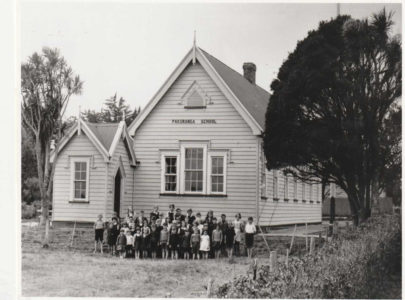
As Howick and districts count down to the 175th anniversary, the Times continues its series by Alan La Roche giving readers a glimpse of life as it used to be. The countdown began at the 170th in 2017
Going to school in the early years of European settlement in Howick was encouraged by some but was not compulsory.
It was not free and some parents claimed three pence a week was expensive. Only 46 per cent of school-age students could read or write in 1858.
Others thought that hard practical work at home was an adequate education. In Ireland, schools were primarily for Protestant students, not Catholics who “made do” with hedgerow schools.
In New Zealand the Catholic priests were eager to make sure all students received a good education. In 1850 in Howick, 139 students attended the Catholic school but only 50 the Protestant school.
Most local Maori had attended Fairburn’s Church Missionary School at Maraetai and could read, write English and wore European-styled clothing when the first European immigrants arrived. They learned the English alphabet ABC, by singing the song “God Save Our Queen” which was later used by other teachers. In 1858 there was a shortage of teachers in New Zealand so the Government offered teachers who stayed in employment for five years, eighty acres as a free incentive.
When Fencible Sergeant Edward Hills was the teacher around 1852 at the Protestant school in Howick, it is thought he made naughty children dig out a well by his cottage, now close to the entrance of Countdown Supermarket in Cook Street. He was a good teacher and was popular with his pupils. In 1899, part of the old Anglican School was moved from Selwyn Road to Cook Street as a church hall and then in 1955 it was moved to Vincent Street for the Howick Girl Guide Hall.
After the 1877 Education Act, education became free, compulsory and secular [no religious instruction] and the Provincial Councils built schools in most communities such as Howick, Panmure, East Tamaki, Whitford, Flat Bush and Pakuranga.
Only Flat Bush School and Pakuranga School survive today. At this time women could teach in state schools and sit on school committees. Pakuranga School was built in 1880 and moved from William Green Domain (named after a popular headmaster at the school) to the Howick Historical Village in 1975. The teacher’s house that was formerly next-door was moved to Pakuranga College and is still in use today.
Being a rural community, many students rode horses to school that could graze in the horse paddock. Initially teachers were reluctant to enforce “compulsory attendance” even though only half the enrolled students attended regularly.
Facilities were considered adequate at that time, such as a drinking mug was hung next to the hand-pump by the school well in the playground. Any pupil caught carving his name or any disfigurement on the wooden desk would be caned and expelled.
Although each classroom had a fireplace, it was considered at the time to be unhealthy to warm the rooms. Pupils brought an enamel mug to school in winter for a hot cocoa drink with sugar and milk for one penny. This tradition continued for about another 70 years. When hay-making occurred or when wheat or oats was harvested, the school closed so that pupils could assist the community harvest. By 1900, most children 5 to 15 years of age attended regularly.
After school in summer those at Pakuranga School swam in a hole by Mooney’s Bridge (near Highland Park). Those at Howick School swam in a dam on a creek in farmland between Rodney and Gibraltar Streets.
- Alan La Roche, Howick Historian










